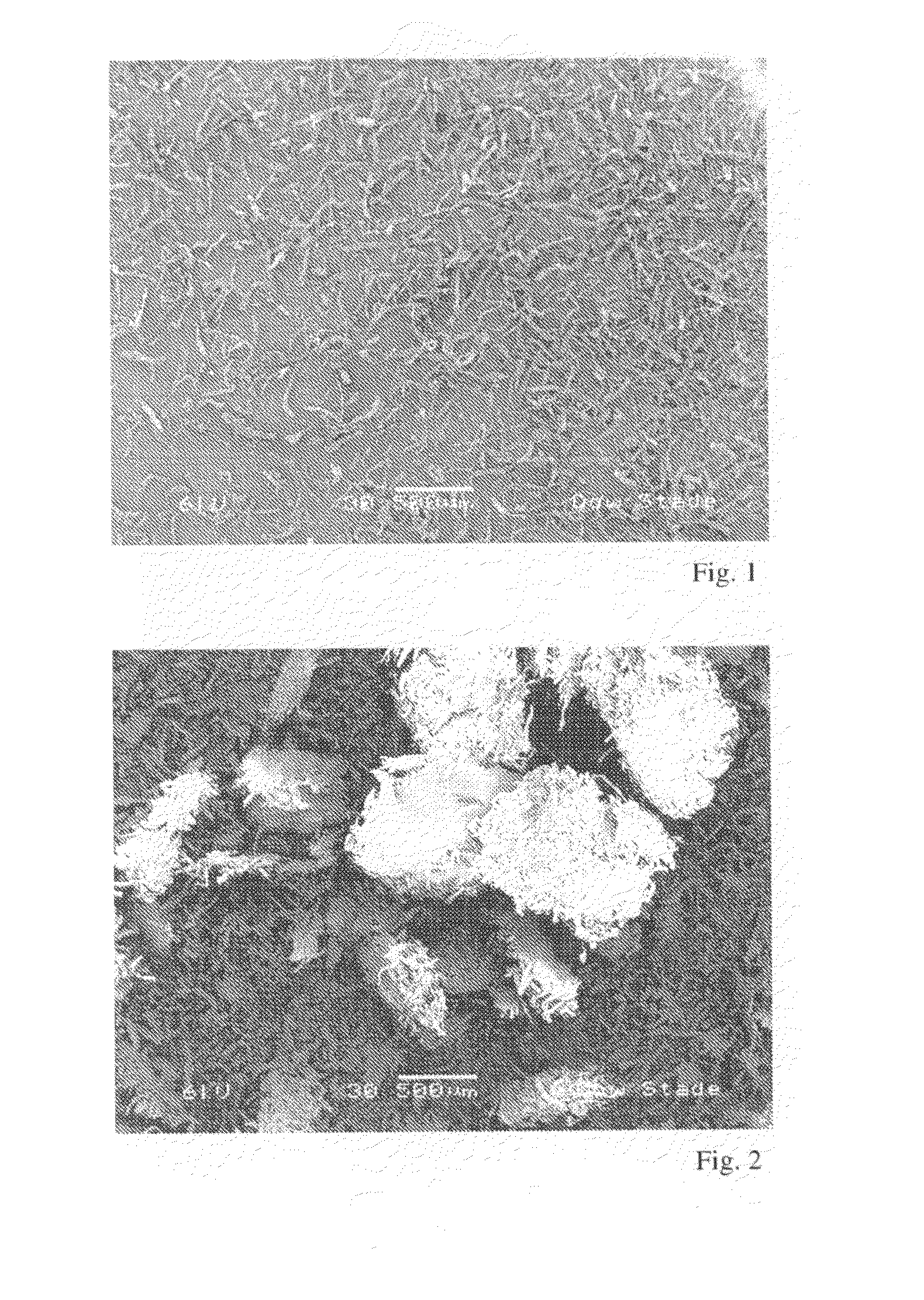Method of preparing alkali cellulose or a cellulose derivative
a technology of cellulose and alkali cellulose, which is applied in the field of preparing alkali cellulose or cellulose derivatives, can solve the problems of high capital investment in pulp processing to a sheet, and achieve the effect of high quality
- Summary
- Abstract
- Description
- Claims
- Application Information
AI Technical Summary
Benefits of technology
Problems solved by technology
Method used
Image
Examples
experiment 1
Comparative Example
[0031]450 g powdery cellulose with the unsettled bulk density of 110 g / l is charged to a horizontal steel reactor and the air is thoroughly replaced with nitrogen. The degree of filling of the reactor with this powdery cellulose is 81 percent. FIG. 1 illustrates a picture of the powdery cellulose taken by Scanning Electron Microscopy (SEM). Then 987 g of 50 percent aqueous caustic and 200 g of dimethylether as inert suspending aid are added under agitation for the activation of the cellulose. After 15 min of alkalization at 40° C. temperature 115 g of propylene oxide and 900 g of chloromethane are fed under agitation. The temperature is raised to 80° C. and the total reaction time is 240 min. Then the reactor pressure is released and the content is slurried with hot water of 90° C. and neutralized with the appropriate amount of acetic acid. The slurry is filtered and washed with additional hot water. The filter cake is then dried and milled. The substitution is de...
experiment 2
Inventive Example
[0032]Powdery cellulose is compacted in a roller compactor into compacted cellulose sheets (slips) applying a specific press force of 20 kN / cm to produce a sheet. The compacted sheet is subsequently broken up to form the granulated cellulose-based material. FIG. 2 illustrates a picture of the granulated cellulose-based material taken by Scanning Electron Microscopy (SEM). 450 g of the granulated cellulose-based material having an unsettled bulk density of 249 g / l is loaded into the reactor and the air is thoroughly replaced with nitrogen. Then 974 g of 50 percent aqueous caustic and 200 g of dimethylether as inert suspending aid are added under agitation for the activation of the cellulose. After 15 min of alkalization at 40° C. temperature 115 g of propylene oxide and 900 g of chloromethane are fed under agitation. The temperature is raised to 80° C. and the total reaction time is 241 min. Then the reactor pressure is released and the content is slurried with hot w...
experiment 3
Inventive Example
[0033]Powdery cellulose is compacted in a roller compactor to produce compacted cellulose sheets (slips) using a specific press force of 20 kN / cm to a produce sheet. The compacted sheet is subsequently broken up to form the compacted, granulated cellulose-based material. 675 g of the granulated cellulose-based material having an unsettled bulk density of 249 g / l are loaded into the reactor and the air is thoroughly replaced with nitrogen. Then 1451 g of 50 percent aqueous caustic and 300 g of dimethylether as inert suspending aid are added under agitation for the activation of the cellulose. After 15 min of alkalization at ambient temperature 173 g of propylene oxide and 1350 g of chloromethane are fed under agitation and the temperature is raised to 80° C. and the total reaction time is 262 min. Then the reactor pressure is released and the content is slurried in hot water, neutralized and further processed as in Experiment 2. The analytical results of the produced...
PUM
| Property | Measurement | Unit |
|---|---|---|
| diameter | aaaaa | aaaaa |
| particle size distribution | aaaaa | aaaaa |
| particle size distribution | aaaaa | aaaaa |
Abstract
Description
Claims
Application Information
 Login to View More
Login to View More - R&D
- Intellectual Property
- Life Sciences
- Materials
- Tech Scout
- Unparalleled Data Quality
- Higher Quality Content
- 60% Fewer Hallucinations
Browse by: Latest US Patents, China's latest patents, Technical Efficacy Thesaurus, Application Domain, Technology Topic, Popular Technical Reports.
© 2025 PatSnap. All rights reserved.Legal|Privacy policy|Modern Slavery Act Transparency Statement|Sitemap|About US| Contact US: help@patsnap.com

